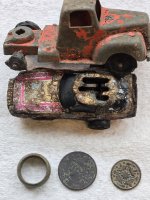Boarteats
Full Member
Quick question for the experienced prospectors in the forum. Is the word 'gossan' synonymous with the term 'gossan cap'? For example, if I find rocks in a stream bed that are iron/manganese oxide/hydroxide concretions, are those rocks gossan even if they are scattered about and do not constitute a 'cap'?
Amazon Forum Fav 👍
Upvote
0








